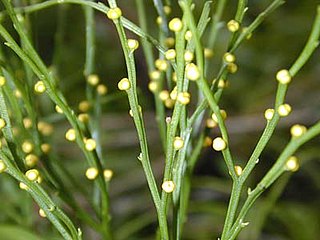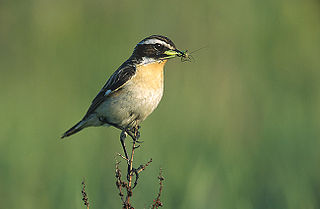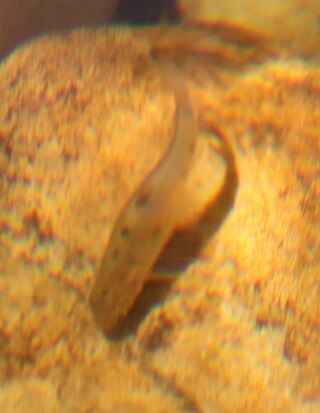
Psilotum is a genus of fern-like vascular plants. It is one of two genera in the family Psilotaceae commonly known as whisk ferns, the other being Tmesipteris. Plants in these two genera were once thought to be descended from the earliest surviving vascular plants, but more recent phylogenies place them as basal ferns, as a sister group to Ophioglossales. They lack true roots and leaves are very reduced, the stems being the organs containing photosynthetic and conducting tissue. There are only two species in Psilotum and a hybrid between the two. They differ from those in Tmesipteris in having stems with many branches and a synangium with three lobes rather than two.

Chats are a group of small Old World insectivorous birds formerly classified as members of the thrush family (Turdidae), but following genetic DNA analysis, are now considered to belong to the Old World flycatcher family (Muscicapidae).

Stelis, or leach orchids, is a large genus of orchids, with perhaps 500 species. The generic name Stelis is the Greek word for 'mistletoe', referring to the epiphytic habit of these species. These mainly epiphytic plants are widely distributed throughout much of South America, Central America, Mexico, the West Indies and Florida. Stelis is abbreviated Ste. in the horticultural trade.

Dendrobium is a genus of mostly epiphytic and lithophytic orchids in the family Orchidaceae. It is a very large genus, containing more than 1,800 species that are found in diverse habitats throughout much of south, east and southeast Asia, including China, Japan, India, the Philippines, Indonesia, Australia, New Guinea, Vietnam and many of the islands of the Pacific. Orchids in this genus have roots that creep over the surface of trees or rocks, rarely having their roots in soil. Up to six leaves develop in a tuft at the tip of a shoot and from one to a large number of flowers are arranged along an unbranched flowering stem. Several attempts have been made to separate Dendrobium into smaller genera, but most have not been accepted by the World Checklist of Selected Plant Families.

Erik Acharius was a Swedish botanist who pioneered the taxonomy of lichens and is known as the "father of lichenology." Acharius was famously the last pupil of Carl Linnaeus.

Lepanthes is a large genus of orchids with about 800–1000 species, distributed in the Antilles and from Mexico through Bolivia. The genus is abbreviated in horticultural trade as Lths. Almost all the species in the genus are small and live in cloud forests. Babyboot orchid is a common name.

Olof Peter Swartz was a Swedish botanist and taxonomist. He is best known for his taxonomic work and studies into pteridophytes.
Kenichthys is a genus of sarcopterygian fish from the Devonian period, and a member of the clade Tetrapodomorpha. The only known species of the genus is Kenichthys campbelli, the first remains of which were found in China in 1993. The genus is important to the study of the evolution of tetrapods due to the unique nature of its nostrils, which provide vital evidence regarding the evolutionary transition of fish-like nostrils to the tetrapod choanae.

Pseudobarbus is a ray-finned fish genus in the family Cyprinidae. The type species is Burchell's redfin. The scientific name is derived from the Ancient Greek pseudes ("false") and the Latin word barbus. This genus contains some of the South African redfins. It was originally proposed as a subgenus, but has since been found worthy of recognition as a full genus.

The Berg River redfin or Berg redfin is an African freshwater fish species in the family Cyprinidae. The Burchell's redfin, the type species of its genus Pseudobarbus, is a very close relative. The Berg River redfin is tetraploid.

Hippopotamyrus is a genus of elephantfish in the family Mormyridae.

Marcusenius is a genus of the elephantfish group native to Africa. Its members are highly diverse in size, with the smallest species reaching less than 15 cm (6 in) and the largest more than 1 m (3.3 ft).

Meriania is a genus of flowering plants in the family Melastomataceae. There are about 93 species distributed from Mexico to Brazil and the Antilles.

Elpistostege is an extinct genus of finned tetrapodomorphs that lived during the Frasnian age of the Late Devonian epoch. Its only known species, E. watsoni, was first described in 1938 by the British palaeontologist Thomas Stanley Westoll, based on a single partial skull roof discovered at the Escuminac Formation in Quebec, Canada.
Nomen illegitimum is a technical term, used mainly in botany. It is usually abbreviated as nom. illeg. Although the International Code of Nomenclature for algae, fungi, and plants uses Latin terms for other kinds of name, the glossary defines the English phrase "illegitimate name" rather than the Latin equivalent. However, the Latin abbreviation is widely used by botanists and mycologists.

Myiomela is a genus of bird in the family Muscicapidae. Some members have sometimes been included in the genus Cinclidium and the phylogeny has not been resolved completely.

Argyrochosma nivea is an Andean fern species in the genus Argyrochosma.
Cypricardinia is an extinct genus of bivalves. Species are found worldwide.

Microtea, the jumby peppers, are a genus of flowering plants in the family Microteaceae, native to the Caribbean islands, Central America, and South America.
Cinclidium is the scientific name of two genera and may refer to:














